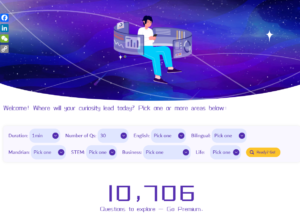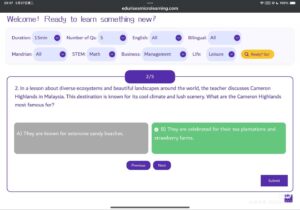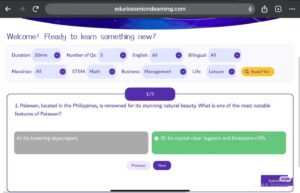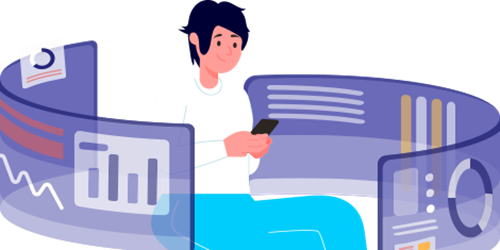I designed a situational learning plan using the EduRises MicroLearning learning platform, aligning with the project’s objective of mastering knowledge through flexible, time-based learning strategies.
1.0 What Is EduRises MicroLearning and Why I Chose It
It offers question-driven learning product that blends bilingual content, cross-disciplinary knowledge, and critical thinking practice.
It’s a highly customizable quiz-based interface, allowing learners to choose the duration of their learning sessions (ranging from 1 to 60 minutes), the number of questions, language preferences (English, Mandarin, or bilingual), and categories across STEM, Business, and Life. These features made it an ideal tool for experimenting with focused learning in various time frames and everyday situations.

1.1 Learning in One Minute: A Surprising Boost in Focus and Recall
I structured my exploration around two specific durations: 1 minute and 15 minutes. For the 1-minute plan, I set the question count to 30, aiming for rapid mental engagement and intuitive recall. This setup was perfect for brief moments during the day—while waiting in line, in an elevator, or between tasks. Despite the short time frame, I found that even a single minute of learning could stimulate cognitive alertness and reinforce known information. It functioned as a quick “mental stretch,” keeping my brain active and engaged with new material.
1.2 Deep Learning in 15 Minutes: A Bilingual, Multi-Topic Experience
In contrast, the 15-minute plan allowed for deeper engagement. I selected targeted categories: Math under STEM, Management in Business, and Leisure from the Life section. I also enabled all language options, combining English and Mandarin content for a more bilingual experience. Each session featured five thoughtfully crafted questions. One such example asked: “What are the Cameron Highlands most famous for?” I successfully answered that they are renowned for their tea plantations and strawberry farms.

Another question focused on Palawan in the Philippines, where I initially chose the wrong answer (“towering skyscrapers”) and later learned the correct one—its “crystal-clear lagoons and limestone cliffs.” This process of encountering, answering, and receiving immediate feedback transformed mistakes into powerful learning moments.

1.4 From Procrastination to Productivity: MicroLearning as a Reset Tool
In my personal usage session, I approached EduRises as both a learner and an experimenter. I was curious about how my brain would perform under light cognitive stress within a short window. I chose a 1-minute session again, this time mixing categories like English and STEM while keeping the bilingual option open. The pressure of speed made me rely on instinct and pattern recognition. I observed how I subconsciously began to prioritize familiar question types to maximize efficiency. It also became clear that even in such a short time, my attention shifted entirely from external distractions to the task in front of me. This was especially helpful during moments of procrastination—offering me an efficient reset. What surprised me most was how refreshing it felt afterward, as though I had completed a meaningful task despite only investing a minute.
Upon completing each session, EduRises provided an “Achievement” summary that tracked performance metrics including current score (e.g., 20/30), time spent (25 min), total cumulative points (234), and overall learning time (75 minutes). Features such as “Review Mistakes” and “Try Again” proved particularly helpful, allowing me to identify knowledge gaps and reattempt exercises for reinforcement. This gamified system encouraged repeated engagement and provided tangible indicators of progress, which kept me motivated to return and continue learning.
1.5 Building a Flexible Learning Framework for Everyday Life
This experience reshaped my perception of how time can be strategically used for personal development. A single minute became an opportunity for fast-paced knowledge review, while fifteen minutes offered room for focus and discovery. The bilingual learning format further enriched the experience by sharpening my language skills and improving cross-cultural awareness. What stood out most was the platform’s adaptability—it fit naturally into the rhythms of everyday life, making meaningful learning possible during commutes, work breaks, or quiet evenings.
Ultimately, this project enhanced my ability to plan, organize, and manage learning experiences within realistic time constraints. It helped me become more intentional about when and how I learn. I came away with a flexible learning framework that can be applied to a wide range of topics and contexts. Most importantly, I learned that meaningful learning doesn’t always require long hours—sometimes, it only takes a moment of focus and the right tool.
2.0 FAQ on EduRises Microlearning
2.1 How does this compare to traditional learning?
- Unlike passive reading, their method emphasizes active recall (through questioning) and cross-disciplinary connections, mirroring real-world knowledge application and integration.
2.2 How does adjustable difficulty work?
- I can adjust difficulty by selecting language (English/bilingual/Chinese) and content depth level (Basic/Medium/Advanced/Integrated) based on my needs.
2.3 How does this improve academic or industry insights?
- By tackling applied learning questions, I train my brain to connect theories to practical scenarios.
Wanna give a try? Let’s go.
- Learn Smarter, Not Longer: My EduRises MicroLearning Review and Daily Strategy - 2025-07-21
- 用Python分析睡眠质量与作息习惯 - 2025-07-08
- 用Python分析健身数据与健康习惯 - 2025-07-01

